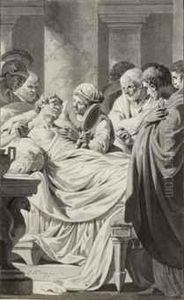Jacques Kuyper Paintings
Jacques Kuyper was a Dutch artist and draftsman, born on August 9, 1761, in Amsterdam, Netherlands. He is known for his contributions to Dutch art during the late 18th century, a period that witnessed a decline in the dominance of the Dutch Golden Age painting and the rise of neoclassicism.
Kuyper's early life is not well-documented, but it is known that he received his artistic training in Amsterdam, where he was influenced by the neoclassical style. Neoclassicism was a widespread movement that sought to return to the classical art of Greece and Rome, and it became a dominant style in Europe following the discovery of the ancient Roman cities of Pompeii and Herculaneum.
Throughout his career, Kuyper worked on various art projects, including illustrations and decorative designs. He was also involved in the production of prints and he contributed to the design of decorative objects and book illustrations, showing a versatility that was typical of artists of his time. His style was characterized by clear lines and a careful attention to form, reflecting the neoclassical ideals of harmony and proportion.
Kuyper's works were appreciated in his time, and he was a member of various art societies. However, unlike some of his contemporaries, Kuyper did not achieve significant fame outside of his native Netherlands. His contributions to the Dutch art scene were modest but respected among his peers.
Jacques Kuyper's life and work were cut short when he died on December 7, 1808, in Amsterdam. Despite his relatively short life and career, his artwork remains a part of the rich tapestry of Dutch neoclassical art. His legacy is preserved in the collections of Dutch museums and archives where his drawings and prints can be studied and appreciated by art historians and enthusiasts of neoclassical art.
